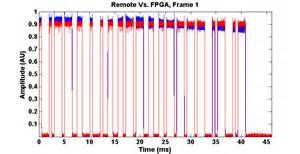Me: Electronics enthusiast in the 1960s, little chance to practice since then.
Project: Schools in the UK have drawers full of expensive 'Data loggers'. Sophisticated and versatile devices with lots of plug-ins to measure and record mostly physics things. Rarely used because teachers don't use them often enough, crucial bit missing, can't get software to work etc.
A posible solution: Ultra-simple hardware with common software. The software I'm trialing is either Audacity or Acoustica audio editing software. Both are available for free, measure at 10kHz+ (plenty fast enough) and resolve to 16bit (again, plenty).
My current problem: I want to fire a narrow beam of visible LED light (not laser, regulations too complex) at a sensor to produce a signal that can be fed into the mic jack on a PC. The resulting pulse. These devices often used in pairs to start/stop a timer to measure acceleration etc but a single one could be used by reflection to count the rotation speed of a fan etc.
Photodiodes and Phototransistors are unknown to me and I have found comments on here (Q22414) like:
Photodiodes may be operated either forward or reverse biased. Forward biased gives most output. Reverse biased gives most speed. and is noisier. Reverse biased mode is most usually used.
I'm thinking that forward bias would be better for me, but where do phototransistors fit in? I suspect that photodarlingtons are a little slow. Help!
My ideal circuit has no IC's, a very low component count and is really cheap. That way any unskilled solderer has a chance of building or repairing it and if it gets lost/broken then it's not a big deal.
Thanks
Oops, I'm trying to reply to comments below but there is a short message length available.
I've got one device working already. A tiny box with 3 leads - one to USB as power supply, one to computer mic input and one with bead thermistor. Inside box is a 555 running at about 9kHz outputting to an R + 2.2V zener - this gives stable square voltage without risk of frying the mic input to computer. The output from that goes across another R + thermistor which gives me a square wave with amplitude varying with temperature.
In the audio editing program this looks like a continuous 'histogram' that goes up and down with temperature. Total cost of components about 5£$Euro, one equivalent is here:
http://www.data-harvest.co.uk/catalogue/science/secondary/smartq-sensors/smartqsensors/3100
My aim is probably not to improve, just simplify. There are already 'magic boxes' that do all the thinking to lots of decimal places , but these only teach the kids to use magic boxes - not to understand the underlying science. An example is the cooling curve of a molten solid. The liquid cools at a steady (not linear) rate but at the freezing/melting point the curve plateaus for a while and then drops again at the original rate. With my device the kids can calibrate the amplitude against a thermometer in different temperatures of water and draw a graph. This teaches more of scientific method than a magic box does.
My intention is to put the LED and the photodiode/transistor into black delrin tubes about 4-5cm long meaning that the beam direction can be deen for alignment but is not affected by ambient light.
It is unlikely that multiple sets of equipment will be use at the same time.
What I am really asking for is guidance on the relative merits of photodiodes compared with phototransistors. The data sheets mean little to me.
Thanks for the input everyone.



